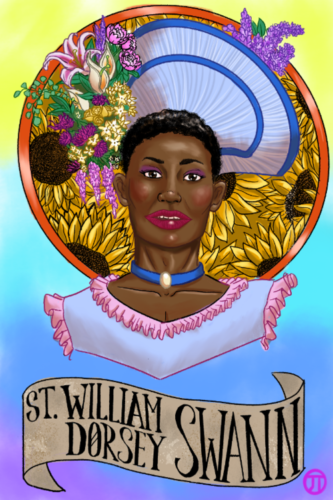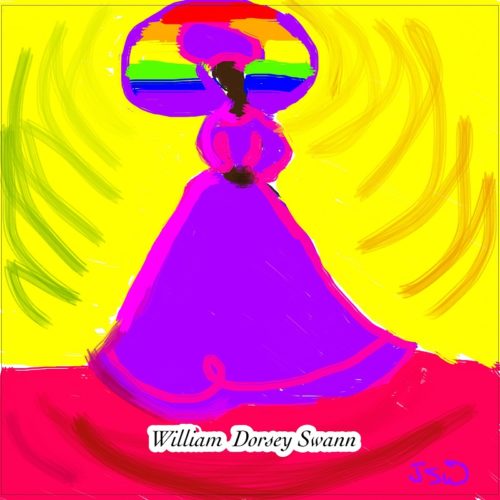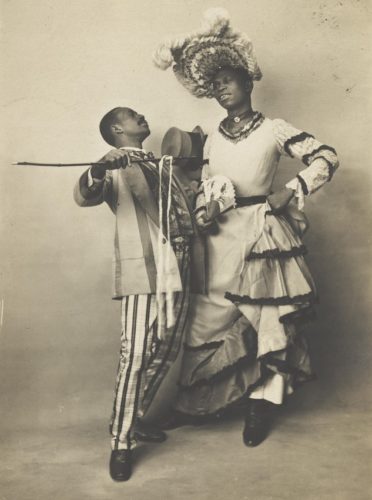Last Updated on April 8, 2024 by Kittredge Cherry

Born into slavery, William Dorsey Swann became the first American to lead a queer resistance group, first to self-identify as a “queen of drag,” and first to use the U.S. legal system to defend the queer community. He battled police in a cream satin gown when they raided a drag ball almost a century before the Stonewall uprising.
Known to his friends as “the Queen,” Swann reigned over the secret world of drag balls in Washington DC during the 1880s. He led a group of former enslaved persons and rebel drag queens known as “House of Swann.” The Washington Post reported how he resisted police on April 12, 1888, in an article headlined, “Negro Dive Raided. Thirteen Black Men Dressed as Women Surprised at Supper and Arrested.” The event is considered one of the first examples of violent resistance for LGBTQ rights.
Swann also made history in 1896 when he requested a pardon from President Grover Cleveland for holding a drag ball. The request was denied, but it was the first time an American took legal action to fight for the right of the queer community to gather.
Reclaiming the heritage of Swann’s courageous life can provide inspiration during today’s LGBTQ Pride and Black Lives Matter movements. He paved the way for Marsha P. Johnson, a black activist who self-identified as a “drag queen.” Johnson and others who fought back when police raided New York City’s Stonewall Inn on June 28, 1969 in a landmark event that helped launch the modern LGBTQ rights movement. Swann was a forerunner to Marsha P. Johnson as a queer black diva who pushed the edges of popular culture and public policy.
Police raided Swann’s ball in April 1888
An excerpt from the forthcoming book is posted at Whiting.org with the announcement that Joseph won its 2019 creative non-fiction grant for his work on Swann. Joseph writes a vivid description of the raid on April 12, 1888:
___________________________________
When the police burst through the door of the two-story residence in northwest Washington, D.C., just half a mile from the White House, they discovered dozens of black men dancing together there, wearing silk and satin dresses made “according to the latest fashions” of 1888. Most of them were former slaves or the children of slaves.
As soon as the partygoers saw the officers, the dancing stopped. The attendees looked on in shock for a brief moment before scurrying to make their getaway. …
William Dorsey Swann, the self-proclaimed “queen” of the gathering, had no intention of running away. It was his thirtieth birthday celebration, and according to The Washington Post, he was “arrayed in a gorgeous dress of cream-colored satin.” Unlike the others, he ran frantically toward the officers in a vain attempt to keep them from entering the room. “The queen stood in an attitude of royal defiance,” The National Republican noted on its front page. Swann, “bursting with rage,” told the police, “‘You is no gentlemen.’” A brawl ensued, and his “handsome” gown was torn to shreds….
___________________________________
Swann was arrested with a dozen other black men that night. It was neither the first nor the last time that Swann was arrested for organizing balls in private homes where African Americans defied norms against wearing clothes of the opposite sex. The House of Swann continued to do drag balls, using a format that is still followed in today’s ballroom culture, with family-like groups or “houses” led by “mothers” and “queens” do competitive walking dances with exaggerated gestures. The culture lives on today in popular TV shows such as “Pose” and “RuPaul’s Drag Race.”
Swann was born into slavery around 1858
Swann was born into slavery around 1858 and was living on a plantation in Hancock, Maryland when Union soldiers marched through in winter 1862. He worked for pioneering women’s rights activist Sara Jane Spencer (1837-1909) in the early 1880s. According to Joseph, Swann’s “intimate friend” was Pierce Lafayette, a formerly enslaved man from Georgia. Before that Lafayette and Felix Hall had a same-sex relationship that Joseph describes as “the earliest documented same-sex romance between two enslaved men in the United States.” After Swann’s retirement around the turn of the century, his younger brother Daniel J. Swann continued providing costumes for Washington’s drag community until his death in 1954.
Artists imagine William Dorsey Swann
There are no known images of Swann, but artists have filled the gap with creative images. Swann has a floral halo in an icon from the Queer Saints Project by Jason Tseng. It appears at the top of this post. Tseng is a Chinese American non-binary illustrator based in New York City. The halo is filled with black-eyed susans, the state flower of Swann’s home state, Maryland. Lilies, lavender and other flowers decorate Swann’s hat to evoke beauty and queerness. He also wears a stylish choker that convey his fashion sense.
The Queer Saints Project honors queer ancestors as modern-day saints of the LGBTQ movement. The series began when Judson Memorial Church commissioned Tseng to create icons of LGBTQ figures to carry in the Queer Liberation March. Tseng honors their contributions and celebrates their inherent divinity by combining images of nature, Christian sacred iconography, and historical photography. The collection continues to grow as Tseng’s artistry “canonizes” more queer saints.

“William Dorsey Swann” by Jeremy Whitner
Q Spirit also asked gay artist Jeremy Whitner to create a portrait of Swann. He wears a purple gown and a halo with the rainbow colors of the LGBTQ community in the 2020 portrait. The curved lines around Swann add a sense of motion to the elegant figure who danced at drag balls and shook up society. The dominant culture tried to erase Swann from history, so his dark face is appropriately left blank. Based in North Carolina, Whitner is a gay Christian mystic in process for ministry with the Disciples of Christ.
What did William Dorsey Swann look like?
Most articles about Swann use photos of a black female impersonator from the early 20th century. But this was an actor performing for straight, white audiences, not the real queer pioneer of 1888 who wore a dress to please himself and his friends at the drag balls.

Two black actors, Gregory and Brown, one in drag, dancing the Cake-Walk in Paris. Photographic postcard, 1903. “Le cake-walk. Dansé au Nouveau Cirque. Les nègres.” (James Gardiner Collection the Wellcome Library)
The tall black transgender woman or “man in drag” wears a long, ruffled dress and a large, frilly bonnet in 1903 postcards and a short video filmed by motion-picture inventor Louis Lumiere. Dancing with a man in a top hat, the drag performer danced the Cake-Walk (a dance developed on plantations) at the Nouveau Cirque in Paris, France.
Swann shakes up history and stands for self-esteem
Joseph describes Swann as “an American version of the mythological gatekeeper who worked to keep his own community protected from the chaos of a hostile world.”
 On an archetypal level, Swann’s surname connects him with the black swan, a symbol of beauty and grace that also teaches self-esteem and transformation through the fairy tale of the Ugly Duckling. They are also a queer significance because the black swans of Australia are large waterbirds whose pairings are one-quarter homosexual.
On an archetypal level, Swann’s surname connects him with the black swan, a symbol of beauty and grace that also teaches self-esteem and transformation through the fairy tale of the Ugly Duckling. They are also a queer significance because the black swans of Australia are large waterbirds whose pairings are one-quarter homosexual.
Writers and videos tell Swann’s story
Swann’s full story will be told in the forthcoming biography “House of Swann: Where Slaves Became Queens — And Changed the World” by award-winning journalist and historical researcher Channing Gerard Joseph. Plans call for release by Crown (Penguin Random House) in North America and by Picador (Macmillan) in the United Kingdom and 79 other nations and territories.
Joseph is on the journalism faculty at the University of Southern California and his website says he “dabbled in drag” in his youth. He also wrote about Q Spirit founder Kittredge Cherry’s book “Art That Dares” way back in 2007 in an article for the New York Sun.
He is working on a film adaptation of Swann’s life in collaboration with Academy Award nominee Lee Daniels, who directed “Precious” and “The Butler,” and Academy Award winner Bruce Cohen, who produced “Milk” and “American Beauty.”
Swann’s life is also examined and celebrated in a 2021 episode of the PBS American Masters’ digital series “Masters of Drag,” by New York drag diva Peppermint.
William Dorsey Swann’s lost history is reclaimed
Swann shakes up historical understandings and illustrates how queer people have existed and resisted in every time, culture and place. Like much of LGBTQ history, Swann and Washington’s other 19th-century drag queens were forgotten and buried. Their history was lost until Joseph stumbled across it while researching another topic. Even prominent gay historians did not know about Swann, so Joseph decided to research and write about Swann himself.
Another long-lost queer African American ancestor of the era is Frances Thompson, who became the first transgender woman to testify before Congress in an investigation into the 1866 Memphis uprising. A decade later Thompson was arrested and outed in the local newspaper for “being a man dressed in women’s clothing.” Thompson is discussed in a chapter by Hannah Rosen in the book “Sex, Love, Race: Crossing Boundaries in North American History.”
Joseph summed up Swann’s importance in a major 2020 article about him in the Nation magazine: “Coming of age at a time when an entirely new form of freedom and self-determination was developing for African Americans, Swann and his house of butlers, coachmen, and cooks—the first Americans to regularly hold cross-dressing balls and the first to fight for the right to do so—arguably laid the foundations of contemporary queer celebration and protest.”
___
Note on pronouns: This article uses he/him/his pronouns for Swann, following the example of Channing Joseph, the historian who uncovered Swann’s life for contemporary readers. Joseph notes that, except for during drag balls, Swann dressed as a man and used masculine pronouns throughout his life.
___
Related links:
“William Dorsey Swann, the Queen of Drag” by Netisha Currie, archives specialist at the National Archives in College Park, MD.
The Black Drag Queens Who Fought Before Stonewall by Channing G. Joseph (outhistory.org)
Rebecca Cox Jackson and Rebecca Perot: Queer black pair founded Shaker religious community in 1800s (Q Spirit)
___
Related book:
“The Prophets” by Robert Jones Jr. (novel about forbidden love between two enslaved young men on a Deep South plantation)
___
Top image credit:
“St. William Dorsey Swann” by Jason Tseng (2021)
___
This post is part of the LGBTQ Saints series by Kittredge Cherry. Traditional and alternative saints, people in the Bible, LGBT and queer martyrs, authors, theologians, religious leaders, artists, deities and other figures of special interest to lesbian, gay, bisexual and transgender and queer (LGBTQ) people and our allies are covered.
This article was originally published on Q Spirit in August 2020, was expanded with new material over time, and was most recently updated on April 8, 2024.
Copyright © Kittredge Cherry. All rights reserved.
Qspirit.net presents the Jesus in Love Blog on LGBTQ spirituality.







Wow. More proof that they couldn’t be protective of the community.
I would love to have this in book format. I just bought “Drag The Complete Story”. I looked in the index and Swann isn’t listed. If they are not in it honey or ain’t the complete story!
I hope to include this article about William Dorsey Swann in a future book about LGBTQ+ saints and heroes.
Thank you so much this really helped me out with an essay I’m writing for History.
This is amazing, thank you for sharing.